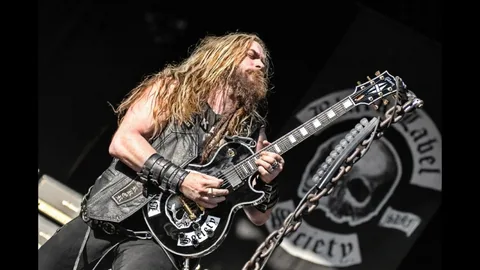
The Sound That Shook Heavy Metal
When Zakk Wylde joined Ozzy Osbourne’s band in the late 1980s, he brought with him a tone that would redefine the Prince of Darkness’s sound. Wylde didn’t just play guitar—he attacked it, using a mix of brute force, precision, and the right gear to forge a sonic identity that was as ferocious as it was articulate. His setup became a viral tiktok songs blueprint for aspiring metal guitarists, with thick distortion, biting harmonics, and jaw-dropping sustain. For fans and players who want to channel that same explosive tone, understanding Zakk’s gear and how he uses it is key. From guitars and pickups to pedals and amps, each component plays a role in delivering that classic Ozzy-era Wylde sound.
The Guitar: Zakk’s Weapon of Choice
Zakk Wylde’s primary guitar during his time with Ozzy has always been the Gibson Les Paul Custom, often sporting his iconic bullseye finish. But it’s more than just looks—this guitar is built like a tank. With a solid mahogany body, maple cap, and set neck construction, it offers the thick tone and long sustain that are trademarks of Wylde’s style. Importantly, Zakk swapped out the stock pickups for EMG 81/85 active humbuckers, which became a huge part of his sound. The EMG 81 in the bridge provides the aggression and attack needed for chugging riffs and slicing leads, while the 85 in the neck is smoother, ideal for fluid solos and melodic phrasing. These pickups helped Zakk cut through the mix on stage and in the studio, providing clarity in high-gain situations.
Strings, Picks, and Tuning
Wylde’s string setup is as heavy as his tone. He typically uses heavy-gauge strings, especially on the low end, which adds punch and prevents flabbiness when down-tuning. Zakk often plays in dropped tunings—like Drop D or half-step down—to give his riffs more depth and weight. Combined with his thick strings and aggressive right-hand attack, this tuning approach gives his playing a thunderous character. He also uses heavy picks, which contribute to his hard-picking style and precise articulation. Pinch harmonics, one of his signature techniques, come more naturally with this type of gear setup and picking pressure. These details, while often overlooked, are critical in replicating his Ozzy-era sound.
The Amp: Marshall Muscle
The foundation of Zakk’s tone is the amp—specifically the Marshall JCM800 2203, a 100-watt beast that has powered many of rock’s greatest tones. Zakk prefers to run his Marshalls loud, letting the power tubes work hard to deliver natural saturation and sustain. He pairs these heads with Marshall 4×12 cabinets, typically loaded with Celestion Vintage 30 or G12T-75 speakers, depending on the era. His EQ settings vary, but he often boosts bass and treble while keeping mids moderate to allow his overdrive pedal to shape the midrange. Running his amp loud gives him dynamics and touch sensitivity that no pedal can truly replicate. It’s this combination of raw power and tonal nuance that lets him swing from crushing rhythms to soaring solos effortlessly.
The Overdrive Pedal: The Heart of the Crunch
While the Marshall amp provides the base distortion, Zakk uses an overdrive pedal to tighten, shape, and boost his tone. His go-to has long been the MXR ZW-44 Berzerker Overdrive, his signature pedal designed to do exactly what he needs: push the amp harder, emphasize mids, and eliminate flabbiness. Before he had a signature model, he used the Boss SD-1 Super Overdrive, which remains a classic for its warm, mid-focused boost. The pedal is typically placed first in the chain after the guitar and before the amp. Zakk runs the gain on the pedal fairly low, tone around noon, and level high, using it more as a boost than a distortion box. This method enhances pick attack and harmonic response, especially useful for those Wylde-style squeals.
Modulation, Wah, and Extras
Though Zakk is best known for his meat-and-potatoes tone, he does incorporate some effects to color his sound. His signature Dunlop ZW-45 Cry Baby Wah is a key part of his soloing toolkit, helping him create vocal-like phrasing and dynamic leads. He also uses chorus pedals, especially in clean sections or to widen his tone—usually from MXR or Boss. Occasionally, you’ll hear delay or reverb in solos, though these effects are used sparingly and tastefully. One of his favorite utility effects is the MXR EVH Phase 90, used for adding subtle movement to sustained notes or leads. Still, the majority of his tone comes from the interaction between guitar, overdrive, and amp, with modulation used as a layer rather than a crutch.
Signal Chain and Live Rig Setup
Zakk’s signal chain is simple but efficient. The guitar feeds into the overdrive pedal, followed by any wah or modulation effects, and then straight into the amp’s input. On some larger rigs, effects like chorus or delay are placed in the amp’s effects loop to maintain clarity. For live shows, Zakk often uses multiple amp heads and cabinets in stereo, which helps create that wall-of-sound effect that fills arenas. He also uses noise gates, such as the MXR Smart Gate, to control feedback and hiss between notes, especially important when using high-gain gear. Every component is rugged and road-tested, and Zakk’s rig is designed to be reliable, consistent, and powerful in any setting.
Playing Style: Gear Meets Technique
Even with the perfect gear, Zakk Wylde’s tone would be incomplete without his aggressive, expressive playing style. His unique combination of wide vibrato, pinch harmonics, alternate picking, and squealing bends is what makes his solos scream and his riffs hit hard. He uses his gear to emphasize these techniques, not mask them. For instance, his overdrive pedal enhances his harmonics and sustain, while his amp dynamics respond to his picking strength. Zakk also makes full use of his volume and tone knobs on the guitar, rolling back for cleaner parts and pushing full-on for solos. These habits show that while gear is important, the hands and the player behind it are what truly shape the sound.
Tone Tips for Guitarists
To achieve a Zakk Wylde tone in the Ozzy Osbourne style, you don’t need to buy his exact gear, but you do need to understand how he uses it. Start with a mahogany-bodied guitar (preferably a Les Paul shape) and install EMG 81/85 pickups or similar active humbuckers. Use a Marshall-style amp with solid headroom and plenty of midrange punch. Add an overdrive pedal and set it as a boost—low gain, high output. Use heavy strings and picks, tune down slightly, and pick aggressively. Pay attention to EQ, avoiding too much gain and letting your technique provide the character. Practice pinch harmonics, vibrato, and phrasing—because tone starts in the fingers, not the pedals.
Conclusion
Zakk Wylde’s contributions to Ozzy Osbourne’s music are legendary, not only for his technical skill but for the powerful and expressive guitar tone he brought to the table. His setup—a Gibson Les Paul Custom, EMG pickups, overdrive into a Marshall amp—has become one of the most imitated in metal. But what sets him apart isn’t just his gear—it’s how he uses it. His tone is the result of intelligent gear choices combined with fierce playing and musical awareness. For guitarists inspired by the Ozzy era of Zakk’s career, the goal isn’t just to copy settings but to understand the principles behind them: clarity, aggression, sustain, and control. With the right gear and approach, you can channel that same sonic spirit and craft your own version of the Wylde sound.

